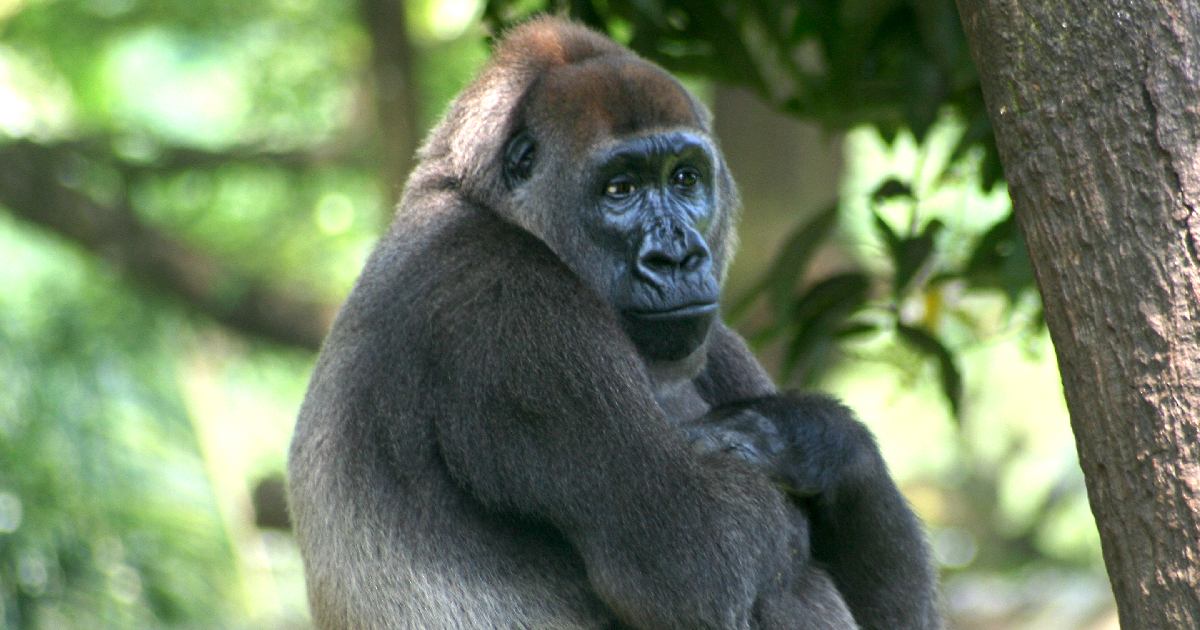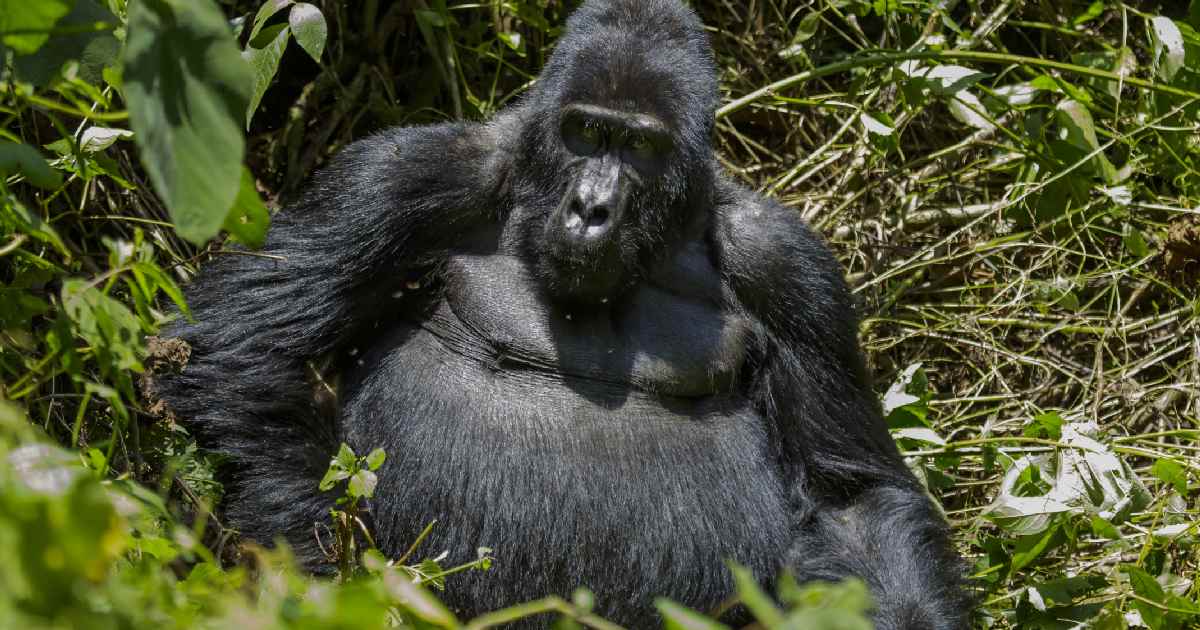Gorillas are among the most fascinating and majestic creatures on our planet. Known for their strength, intelligence, and social structures, these great apes capture our imagination and attention. There are two primary species of gorillas: the eastern gorilla and the western gorilla. Each of these species is further divided into two subspecies. The eastern gorilla species includes the Mountain gorilla and the Eastern Lowland gorilla, while the western gorilla species comprises the cross-river gorilla and the Western Lowland gorilla.
Within the gorilla family, there are several subspecies, each with unique characteristics and habitats. This article will delve into the details of the largest gorilla species in the world, providing insights into their sizes, locations, key features, and the threats they face. Join us as we explore the world of the eastern lowland gorilla, western lowland gorilla, mountain gorilla, and cross-river gorilla.
4. Western Lowland Gorilla

- Size: Adult males weigh up to 350 pounds and stand about 5 feet tall.
- Location: West and Central Africa, including countries like Cameroon and Gabon.
- Key Feature: Smaller than eastern gorillas with a more varied diet and distinct reddish-brown hair.
Western lowland gorillas are the most numerous and widespread of all gorilla subspecies. These gorillas inhabit the dense forests and swamps of West and Central Africa, including countries like Cameroon, Gabon, and the Central African Republic. Adult males, or silverbacks, typically weigh up to 350 pounds, slightly smaller than their eastern cousins but still formidable in size and strength. Western lowland gorillas have a more varied diet, consuming a wider range of fruits, leaves, and insects.
One distinguishing feature of western lowland gorillas is their reddish-brown hair, especially on the crown of their heads. This characteristic sets them apart from other gorilla subspecies. Despite being more numerous, western lowland gorillas are also critically endangered, facing threats from habitat destruction, bushmeat hunting, and diseases like Ebola. Conservation efforts are crucial to ensuring that these magnificent creatures continue to thrive in their natural habitats.
In their natural habitats, western lowland gorillas form social groups led by a dominant silverback. These groups include several adult females and their offspring, with each member playing a vital role in the group’s survival. The social dynamics of western gorillas are complex, involving intricate communication and cooperation among group members. Understanding these social structures is essential for conservationists working to protect these incredible animals.
3. Cross River Gorilla

- Size: Adult males weigh up to 400 pounds and stand around 5.5 feet tall.
- Location: Border regions between Nigeria and Cameroon.
- Key Feature: Most endangered gorilla subspecies with distinctive skull and dental characteristics.
The Cross River gorilla is the most endangered gorilla subspecies, with only a few hundred individuals remaining in the wild. These gorillas are found in the mountainous border regions between Nigeria and Cameroon, living in small, isolated groups. Adult males can weigh up to 400 pounds and stand around 5.5 feet tall. Cross River gorillas are similar in size to eastern lowland gorillas but have distinct skull and dental characteristics that set them apart.
Due to their critically endangered status, Cross River gorillas are the focus of intense conservation efforts. Their habitats are fragmented and threatened by human activities such as logging and agriculture. Protecting these gorillas requires collaboration between local communities, governments, and conservation organizations. Understanding the unique features and needs of Cross River gorillas is essential for their preservation.
The habitats of Cross River gorillas are often fragmented, creating isolated populations that are more vulnerable to genetic inbreeding and environmental changes. Conservationists are working to create wildlife corridors that connect these fragmented habitats, allowing for greater genetic diversity and movement between groups. Community engagement and education are also key components of conservation strategies, helping local people understand the importance of protecting these unique gorillas.
2. Mountain Gorilla

- Size: Adult males can weigh up to 430 pounds and stand over 5.6 feet tall.
- Location: Mountainous regions of Rwanda, Uganda, and the Democratic Republic of Congo.
- Key Feature: Thick fur adapted to cold climates and a smaller, more isolated population.
Mountain gorillas are perhaps the most iconic of all gorilla subspecies, known for their rugged, mountainous habitats in central Africa. These gorillas are found in the dense forests of the Virunga Volcanoes region, which spans Rwanda, Uganda, and the Democratic Republic of Congo. Mountain gorillas are adapted to their cold, high-altitude environments with thick fur that helps them stay warm. Adult males, known as silverbacks, can weigh up to 430 pounds and stand over 5.6 feet tall, making them one of the largest gorilla species.
Mountain gorillas live in small, close-knit family groups led by a dominant silverback. They spend much of their time foraging for food, which includes leaves, stems, and bamboo shoots. Despite their strength and size, mountain gorillas are gentle and social animals. Their populations are critically endangered due to habitat loss, poaching, and disease. Conservation efforts, such as protected areas and anti-poaching measures, are vital to the survival of mountain gorillas.
Mountain gorillas inhabit regions that are often inaccessible and challenging to navigate, which provides them with some protection from human encroachment. However, this isolation also means that their populations are smaller and more vulnerable to genetic bottlenecks. Conservationists work tirelessly to monitor and protect mountain gorilla populations, employing strategies like habitat restoration and community-based conservation programs.
1. Eastern Lowland Gorilla

- Size: Adult males weigh up to 440 pounds and can stand over 5.5 feet tall.
- Location: Democratic Republic of Congo.
- Key Feature: Largest of all gorilla subspecies, with a robust build and shorter limbs.
Eastern lowland gorillas, also known as Grauer’s gorillas, are the largest gorilla species in the world. These magnificent creatures are found primarily in the lowland tropical forests of the Democratic Republic of Congo. They are known for their impressive size and strength, with adult males, known as silverbacks, weighing up to 440 pounds. Despite their formidable appearance, eastern lowland gorillas are gentle giants, spending much of their time foraging for food and caring for their families.
These gorillas have a diet that mainly consists of fruits, leaves, and stems, which they find in abundance within their forest habitats. The eastern lowland gorilla habitat is characterized by dense, lush forests that provide ample food sources and shelter. However, these gorillas are critically endangered due to habitat destruction, poaching, and disease. Efforts are being made to protect these incredible animals, but their future remains uncertain. Understanding and preserving the unique qualities of the eastern lowland gorillas is crucial for their survival.
Eastern lowland gorillas live in groups led by a dominant adult male, who ensures the safety and cohesion of the group. These social structures are complex, with adult females and their offspring forming close bonds. The rich biodiversity of their habitat supports their varied diet and provides the resources needed for their survival. However, the encroachment of human activities poses significant threats to their natural environment, making conservation efforts vital.
Conclusion
Gorillas are remarkable creatures, each subspecies offering a glimpse into the diversity and complexity of the natural world. The eastern lowland gorilla, western lowland gorilla, mountain gorilla, and Cross River gorilla all face significant challenges to their survival. As the largest gorilla species in the world, the eastern lowland gorilla stands out for its size and strength. However, all gorilla populations need our attention and efforts to ensure their future.
Conservation is not just about protecting these magnificent animals; it’s about preserving the ecosystems they inhabit and the balance of nature. By understanding the unique characteristics and threats faced by each gorilla subspecies, we can better advocate for their protection and contribute to global conservation efforts. Wild gorillas are an irreplaceable part of our world’s biodiversity, and it is our responsibility to ensure that they continue to thrive for generations to come.
Frequently Asked Questions (FAQs)
What species of gorilla is the largest?
The Eastern Lowland Gorilla, also known as Grauer’s gorilla, is the largest gorilla species. Adult males, known as silverbacks, can weigh up to 440 pounds and stand over 5.5 feet tall. These gorillas are known for their robust build and strength, making them the heaviest and largest of all gorilla subspecies.
What is the most aggressive gorilla?
Gorillas are generally gentle and shy; however, when threatened, adult male silverbacks can become very aggressive to protect their group. There are no specific gorilla subspecies known for being the most aggressive, but individual silverbacks, regardless of subspecies, can exhibit significant aggression when their family is in danger.
What is the strongest gorilla subspecies?
The Eastern Lowland Gorilla is considered the strongest due to its sheer size and muscular build. Adult males can weigh up to 440 pounds and possess immense strength, enabling them to break vegetation and defend their group effectively. Their robust physicality sets them apart as the strongest among the gorilla subspecies.
How many gorilla species are there?
There are two primary species of gorillas: the Eastern Gorilla and the Western Gorilla. Each species is further divided into two subspecies. The Eastern Gorilla species includes the Mountain Gorilla and the Eastern Lowland Gorilla, while the Western Gorilla species comprises the Cross River Gorilla and the Western Lowland Gorilla.
What is the rarest gorilla in the world?
The Cross River Gorilla is the rarest gorilla subspecies, with only a few hundred individuals remaining in the wild. These gorillas inhabit the mountainous border regions between Nigeria and Cameroon and are critically endangered due to habitat loss and poaching. Conservation efforts are crucial for their survival.

